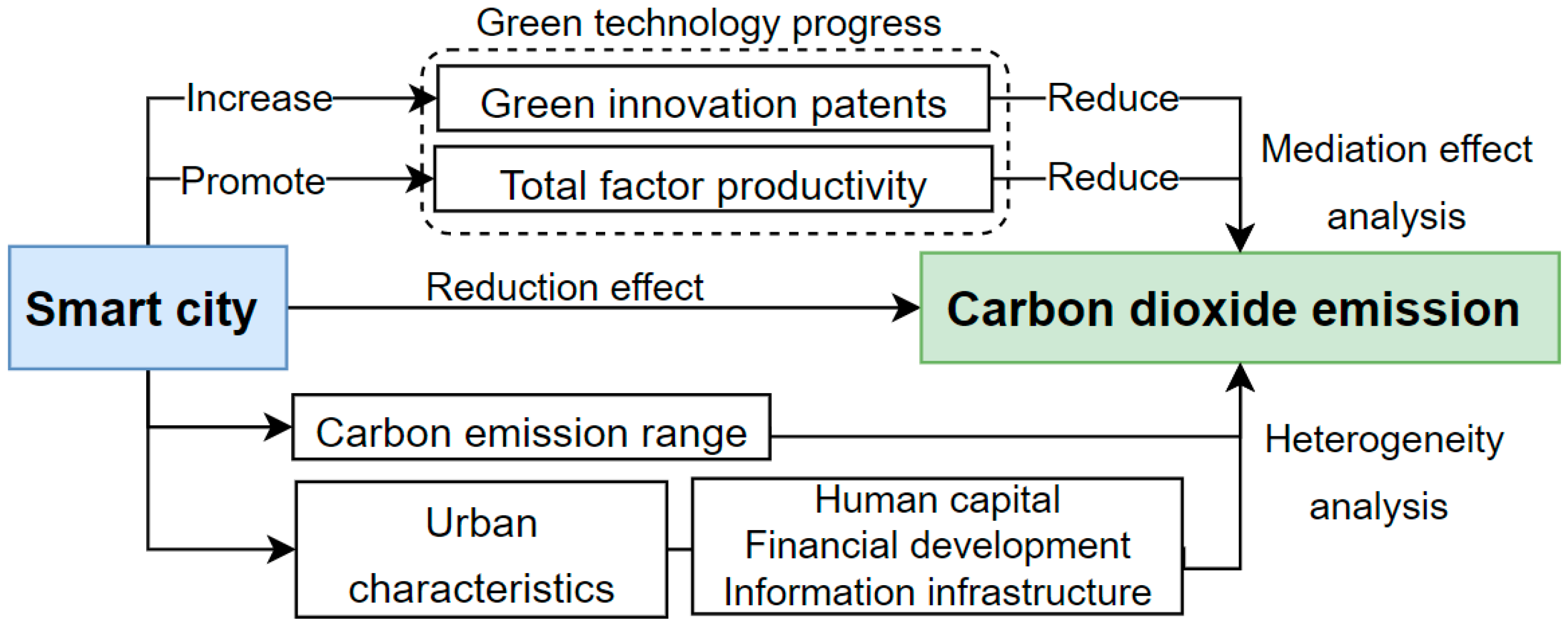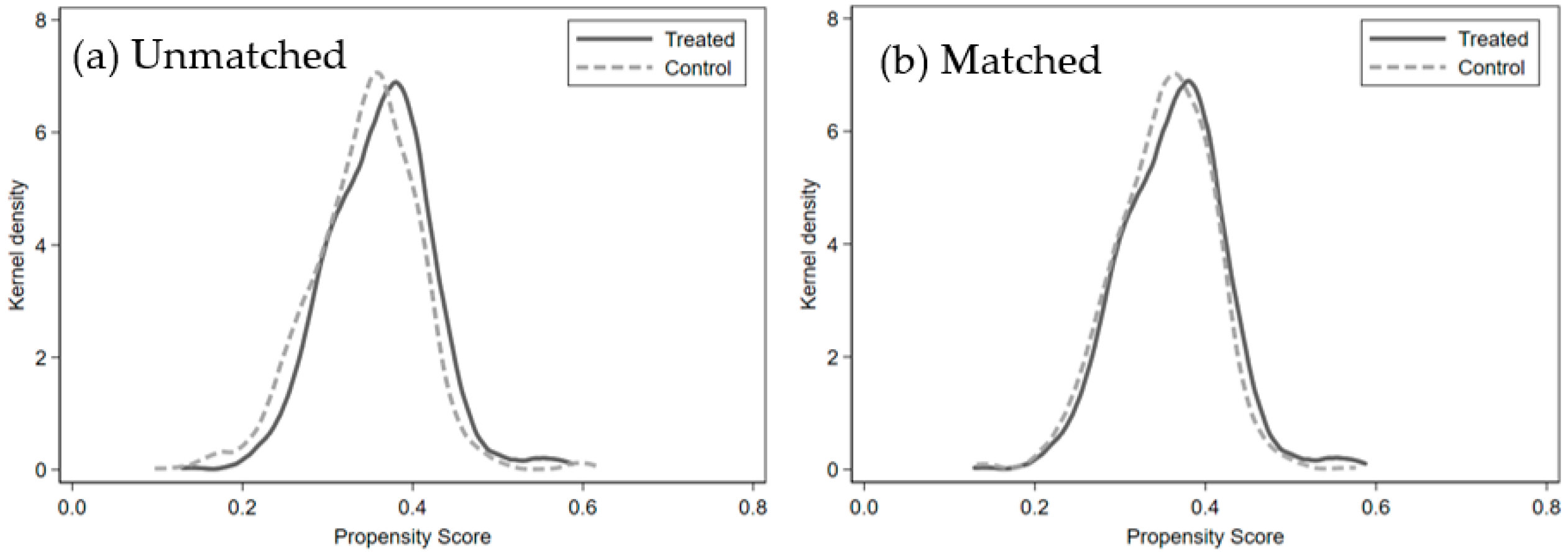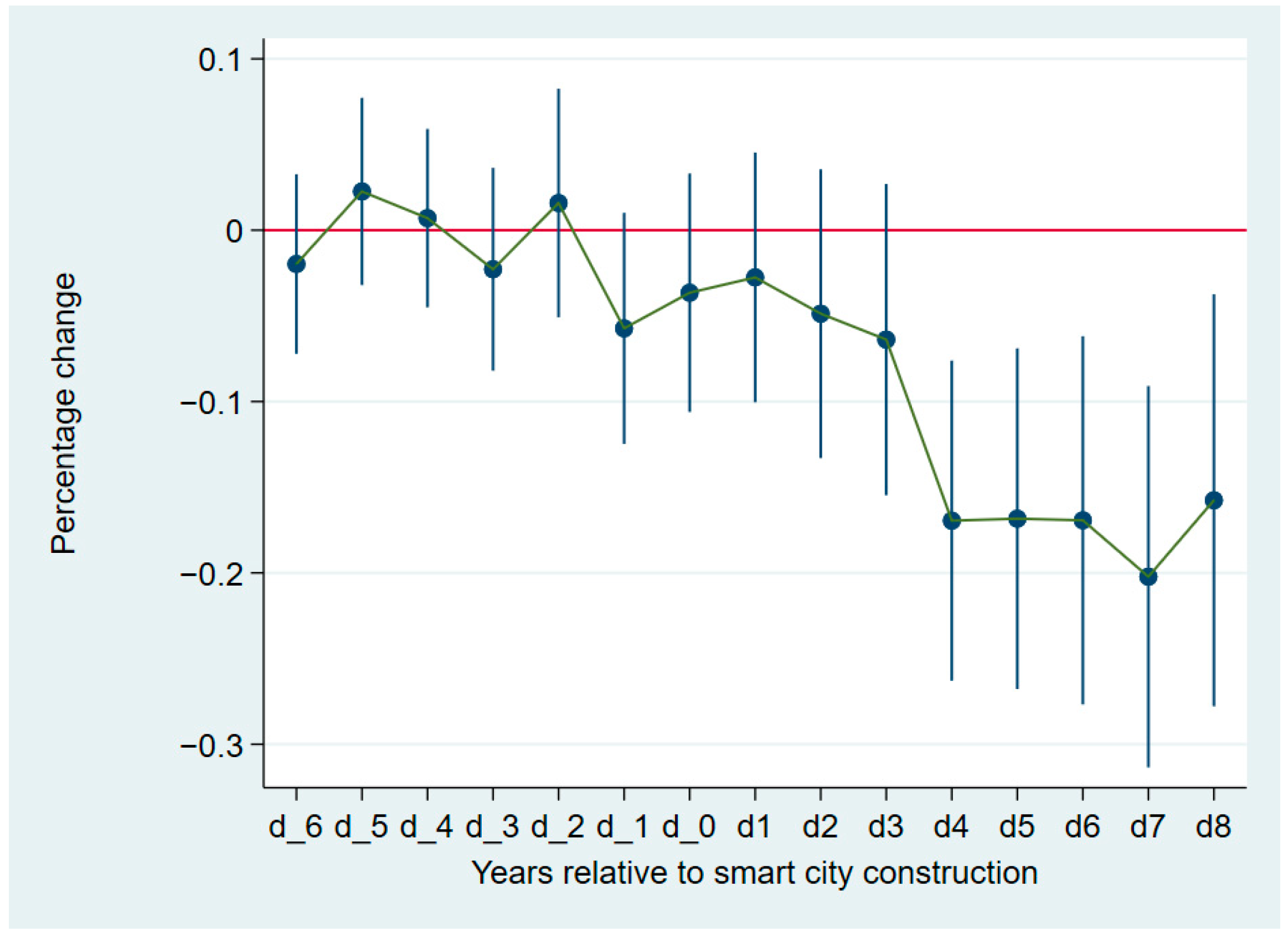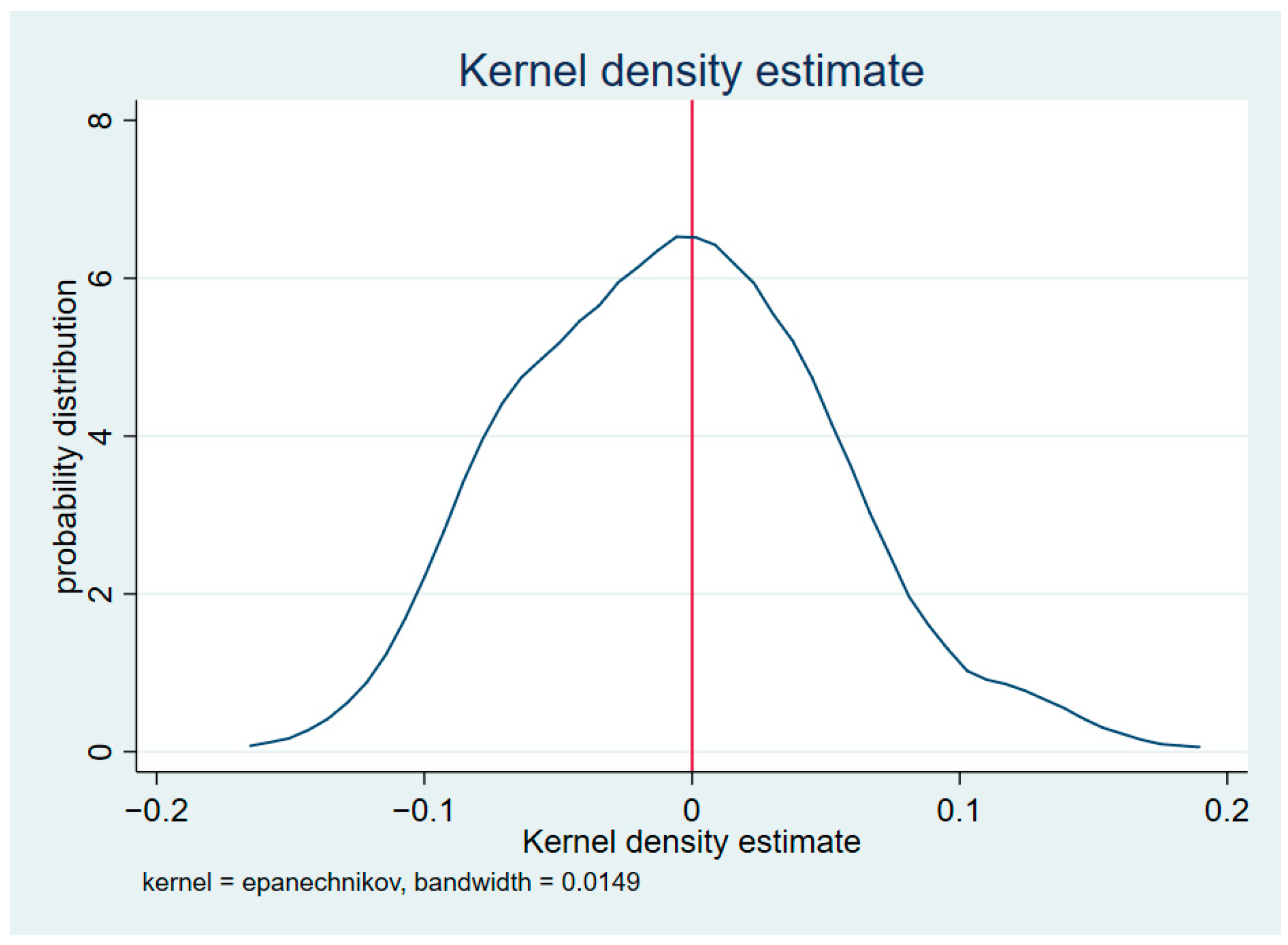Smarter and Cleaner? The Carbon Reduction Effect of Smart Cities: A Perspective on Green Technology Progress
Abstract
1. Introduction
2. Materials and Methods
2.1. The Problem Statement
2.2. Research Framework and Mechanism Analysis
2.2.1. Total Factor Productivity (TFP)
2.2.2. Green Innovation Patents
2.3. Model Setting
2.4. Data Source
2.5. Variable Selection
2.5.1. Independent Variable
2.5.2. Dependent Variable
2.5.3. Control Variables
3. Results
3.1. Preliminary Test of the Effect of SCC on Carbon Dioxide Emission
3.2. Test Based on the PSM-DID Method
3.2.1. Balance Test and Co-Support Test
3.2.2. Test Results Based on PSM-DID
3.3. Robustness Test
3.3.1. Dynamic Results of Equilibrium Trend Test
3.3.2. Placebo Test
3.3.3. Other Robustness Tests
4. Discussion
4.1. Mediation Effect Analysis
4.2. Analysis of Heterogeneity
4.2.1. Carbon Emission Range
4.2.2. Urban Characteristics
5. Conclusions
Author Contributions
Funding
Institutional Review Board Statement
Informed Consent Statement
Data Availability Statement
Conflicts of Interest
References
- Bai, C.; Du, K.; Yu, Y.; Feng, C. Understanding the Trend of Total Factor Carbon Productivity in the World: Insights from Convergence Analysis. Energy Econ. 2019, 81, 698–708. [Google Scholar] [CrossRef]
- Shu, Y.; Deng, N.; Wu, Y.; Bao, S.; Bie, A. Urban Governance and Sustainable Development: The Effect of Smart City on Carbon Emission in China. Technol. Forecast. Soc. Chang. 2023, 193, 122643. [Google Scholar] [CrossRef]
- Lee, K.H.; Min, B. Green R&D for Eco-innovation and Its Impact on Carbon Emissions and Firm Performance. J. Clean. Prod. 2015, 108, 534–542. [Google Scholar]
- Acemoglu, D.; Aghion, P.; Bursztyn, L.; Hemous, D. The Environment and Directed Technical Change. Am. Econ. Rev. 2012, 102, 131–166. [Google Scholar] [CrossRef] [PubMed]
- Zhao, Z.-Y.; Gao, L.; Zuo, J. How National Policies Facilitate Low Carbon City Development: A China Study. J. Clean. Prod. 2019, 234, 743–754. [Google Scholar] [CrossRef]
- He, N.; Zeng, S.; Jin, G. Achieving Synergy between Carbon Mitigation and Pollution Reduction: Does Green Finance Matter? J. Environ. Manag. 2023, 342, 118356. [Google Scholar] [CrossRef]
- Auffhammer, M.; Sun, W.; Wu, J.; Zheng, S. The Decomposition and Dynamics of Industrial Carbon Dioxide Emissions for 287 Chinese Cities in 1998–2009. J. Econ. Surv. 2016, 30, 460–481. [Google Scholar] [CrossRef]
- Shi, K.; Chen, Y.; Li, L.; Huang, C. Spatiotemporal Variations of Urban CO2 Emissions in China: A Multiscale Perspective. Appl. Energy 2018, 211, 218–229. [Google Scholar] [CrossRef]
- Yang, G. Can the Low-Carbon City Pilot Policy Promote Firms’ Low-Carbon Innovation: Evidence from China. PLoS ONE 2023, 18, e0277879. [Google Scholar] [CrossRef]
- Ferrara, R. The Smart City and the Green Economy in Europe: A Critical Approach. Energies 2015, 8, 4724–4734. [Google Scholar] [CrossRef]
- Albino, V.; Berardi, U.; Dangelico, R.M. Smart Cities: Definitions, Dimensions, Performance, and Initiatives. J. Urban Technol. 2015, 22, 3–21. [Google Scholar] [CrossRef]
- Ismagilova, E.; Hughes, L.; Dwivedi, Y.K.; Raman, K.R. Smart Cities: Advances in Research—An Information Systems Perspective. Int. J. Inf. Manag. 2019, 47, 88–100. [Google Scholar] [CrossRef]
- March, H.; Ribera-Fumaz, R. Smart Contradictions: The Politics of Making Barcelona a Self-Sufficient City. Eur. Urban Reg. Stud. 2016, 23, 816–830. [Google Scholar] [CrossRef]
- Pow, C.P.; Neo, H. Seeing Red Over Green: Contesting Urban Sustainabilities in China. Urban Stud. 2013, 50, 2256–2274. [Google Scholar] [CrossRef]
- Söderström, O.; Paasche, T.; Klauser, F. Smart Cities as Corporate Storytelling. City: Anal. Urban Trends 2014, 18, 906716. [Google Scholar] [CrossRef]
- Vanolo, A. Smartmentality: The Smart City as Disciplinary Strategy. Urban Stud. 2014, 51, 883–898. [Google Scholar] [CrossRef]
- Hollands, R.G. Will the Real Smart City Please Stand up?: Intelligent, Progressive or Entrepreneurial? City 2008, 12, 303–320. [Google Scholar] [CrossRef]
- Giffinger, R.; Fertner, C.; Kramar, H.; Kalasek, R.; Pichler-Milanovic, N.; Meijers, E. Smart Cities Ranking: An Effective Instrument for the Positioning of the Cities? Cent. Eur. Conf. Inf. Intell. Syst. 2010, 4, 7–26. [Google Scholar] [CrossRef]
- Zhang, X.; Zhao, P.; Wang, J. The Impact of Smart City on Economic Growth: Evidence from China. Sustainability 2019, 11, 4986. [Google Scholar]
- Yu, H.; Huang, H.; Zhu, X. The Impact of Smart City Initiatives on Urban Sustainability: A Moderating Mediation Analysis. Sustainability 2020, 12, 5207. [Google Scholar]
- Chu, Z.; Cheng, M.; Yu, N.N. A smart city is a less polluted city. Technol. Forecast. Soc. Chang. 2021, 172, 121037. [Google Scholar] [CrossRef]
- Zawieska, J.; Pieriegud, J. Smart city as a tool for sustainable mobility and transport decarbonisation. Transp. Policy 2018, 63, 39–50. [Google Scholar] [CrossRef]
- Wu, S. Smart cities and urban household carbon emissions: A perspective on smart city development policy in China. J. Clean. Prod. 2022, 373, 133877. [Google Scholar] [CrossRef]
- Wu, Z.; Wang, X. The impacts of smart city construction on carbon total factor productivity: Empirical evidence from China. Clean Technol. Environ. Policy 2024. [Google Scholar] [CrossRef]
- Xie, Q.; Fan, X. Carbon emission reduction effects of green finance reform and innovation pilot zones policy: Evidence from the prefecture-level city in China. Environ. Sci. Pollut. Res. 2023, 30, 102624–102640. [Google Scholar] [CrossRef]
- Li, X.; Zhao, C.; Huang, M. Reassessing the effect of low-carbon city policy in China: New evidence from the nighttime light data. Front. Energy Res. 2022, 9, 798448. [Google Scholar] [CrossRef]
- Chen, D.; Chen, S.; Jin, H. Industrial Agglomeration and CO2 Emissions: Evidence from 187 Chinese Prefecture-level Cities over 2005–2013. J. Clean. Prod. 2018, 172, 993–1003. [Google Scholar] [CrossRef]
- Xu, W.X.; Zhou, J.P.; Liu, C.J. The impact of digital economy on urban carbon emissions: Based on the analysis of spatial effects. Geogr. Res. 2022, 41, 111–129. [Google Scholar]
- Li, Z.; Shao, S.; Shi, X.; Sun, Y.P.; Zhang, X.L. Structural transformation of manufacturing, natural resource dependence, and carbon emissions reduction: Evidence of a threshold effect from China. J. Clean. Prod. 2019, 206, 920–927. [Google Scholar] [CrossRef]
- Xu, S.; Xiong, Y. Has the smart city construction reduced energy consumption? Evidence from China. Manag. Environ. Qual. 2024. ahead-of-print. [Google Scholar] [CrossRef]
- Batty, M.; Axhausen, K.W.; Giannotti, F.; Pozdnoukhov, A.; Bazzani, A.; Wachowicz, M.; Ouzounis, G.; Portugali, Y. Smart Cities of the Future. Eur. Phys. J. Spec. Top. 2012, 214, 481–518. [Google Scholar] [CrossRef]
- Francesco, P.A.; Marcos, L.; Sotirios, P. Understanding Smart Cities: Innovation ecosystems, technological advancements, and societal challenges. Technol. Forecast. Soc. Chang. 2019, 142, 1–14. [Google Scholar] [CrossRef]






| Group | Variable | N | Mean | P50 | Sd | Group | Variable | N | Mean | P50 | Sd |
|---|---|---|---|---|---|---|---|---|---|---|---|
| Control Group | CO2 | 1984 | 2.85 | 2.93 | 0.93 | Treated Group | CO2 | 1456 | 2.61 | 2.63 | 0.95 |
| SCC | 1984 | 0 | 0 | 0 | SCC | 1456 | 0.38 | 0 | 0.49 | ||
| Sec | 1984 | 46.56 | 47 | 11.07 | Sec | 1456 | 49.93 | 50.53 | 11.62 | ||
| Fdi | 1984 | 3.18 | 1.2 | 5.99 | Fdi | 1456 | 3.17 | 1.67 | 4.36 | ||
| Govs | 1984 | 17.2 | 14.29 | 22.32 | Gov | 1456 | 14.67 | 12.64 | 10.32 | ||
| Ae | 1984 | 94.01 | 100.01 | 24.65 | Ae | 1456 | 96.26 | 100.12 | 59.73 | ||
| Pop | 1984 | 1217.3 | 87.45 | 34,742.82 | Pop | 1456 | 158.47 | 115.46 | 152.82 | ||
| Inv | 1984 | 6.03 | 6.82 | 2.77 | Inv | 1456 | 6.39 | 7.25 | 2.90 |
| Variable | (1) | (2) | (3) |
|---|---|---|---|
| Carbon Dioxide Emission | |||
| SCC | −0.058 * | −0.116 *** | −0.114 *** |
| (0.033) | (0.033) | (0.033) | |
| Sec | −0.002 * | −0.003 ** | −0.012 *** |
| (0.001) | (0.001) | (0.001) | |
| Fdi | −0.003 * | −0.003 * | −0.002 |
| (0.002) | (0.002) | (0.001) | |
| Govs | 0.001 | 0.001 * | 0.007 ** |
| (0.001) | (0.001) | (0.003) | |
| Ae | −0.000 | −0.000 | −0.000 ** |
| (0.000) | (0.000) | (0.000) | |
| Pop | −0.002 | −0.002 | −0.187 *** |
| (0.024) | (0.023) | (0.066) | |
| Inv | −0.000 | −0.000 | 0.001 *** |
| (0.000) | (0.000) | (0.000) | |
| _cons | 2.240 *** | 1.923 *** | −4.127 *** |
| (0.353) | (0.348) | (0.336) | |
| Time-fixed effects | YES | NO | YES |
| City-fixed effects | NO | YES | YES |
| N | 3440 | 3440 | 3440 |
| F | 163.763 | 122.597 | |
| R2_a | 0.720 | 0.787 | |
| Variable | Unmatched | Mean | t Test (p Value) | %Bias | %Reduct | |
|---|---|---|---|---|---|---|
| Matched | Treated | Control | |Bias| | |||
| Sec | UM | 50.59 | 47.59 | 7.22 (0.00) | 28.6 | 99.3 |
| M | 50.61 | 50.64 | −0.05 (0.96) | −0.2 | ||
| Fdi | UM | 3.33 | 3.41 | −0.34 (0.73) | −1.4 | 75.8 |
| M | 3.33 | 3.31 | 0.09 (0.93) | 0.3 | ||
| Govs | UM | 13.67 | 15.37 | −4.89 (0.00) | −19.0 | 84.0 |
| M | 14.45 | 13.72 | −1.04 (0.30) | −3.0 | ||
| Ae | UM | 951.87 | 924.97 | 1.39 (0.17) | 5.2 | 93.2 |
| M | 932.75 | 934.58 | −0.16 (0.87) | −0.4 | ||
| Pop | UM | 171.80 | 146.57 | 4.09 (0.00) | 16.1 | 98.9 |
| M | 169.81 | 170.09 | −0.04 (0.97) | −0.2 | ||
| Inv | UM | 6.41 | 6.06 | 3.03 (0.00) | 11.9 | 94.1 |
| M | 6.40 | 6.38 | 0.17 (0.87) | 0.7 | ||
| Pseudo R2 | UM | 0.033 | ||||
| M | 0.001 | |||||
| Variable | (1) | (2) | (3) |
|---|---|---|---|
| Radius Matching | Kernel Matching | Nearest Neighbor Matching | |
| SCC | −0.112 *** | −0.166 *** | −0.166 *** |
| (0.034) | (0.034) | (0.033) | |
| Time-fixed effects | YES | YES | YES |
| City-fixed effects | YES | YES | YES |
| Control variable | YES | YES | YES |
| R2 | 0.9478 | 0.9470 | 0.9470 |
| N | 3440 | 3440 | 3440 |
| Variable | (1) | (2) | |||
|---|---|---|---|---|---|
| Level of Trimming | Counterfactual Test | ||||
| 2% | 5% | 10% | |||
| SCC | −0.115 *** (0.034) | −0.118 *** (0.034) | −0.117 *** (0.035) | −0.062 (0.148) | −0.0217 (0.024) |
| Time-fixed effects | YES | YES | YES | YES | YES |
| City-fixed effects | YES | YES | YES | YES | YES |
| Control variable | YES | YES | YES | YES | YES |
| N | 2891 | 2803 | 2655 | 2678 | 1215 |
| Variable | (1) | (2) | (3) | (4) |
|---|---|---|---|---|
| Carbon Dioxide Emission | TFP | Green Innovation Patents | Carbon Dioxide Emission | |
| SCC | −0.114 *** | 0.202 *** | 0.151 *** | −0.109 *** |
| (0.033) | (0.061) | (0.043) | (0.031) | |
| TFP | 0.232 *** | |||
| (0.082) | ||||
| Green innovation patents | 0.021 * | |||
| (0.012) | ||||
| Time-fixed effects | YES | YES | YES | YES |
| City-fixed effects | YES | YES | YES | YES |
| Control variable | YES | YES | YES | YES |
| N | 3440 | 3440 | 3440 | 3440 |
| Variable | (1) | (2) | (3) | (4) | (5) | (6) |
|---|---|---|---|---|---|---|
| Transportation and Construction | Industrial Production Processes | Agriculture, Forestry, and Land Use Change | Waste Disposal Activities | Outsourced Electricity | Heating or Cooling | |
| SCC | −0.178 *** | −0.239 ** | −0.108 * | −0.145 * | −0.010 | −0.095 |
| (0.061) | (0.105) | (0.060) | (0.086) | (0.063) | (0.064) | |
| Time-fixed effects | YES | YES | YES | YES | YES | YES |
| City-fixed effects | YES | YES | YES | YES | YES | YES |
| Control variable | YES | YES | YES | YES | YES | YES |
| N | 3440 | 3440 | 3440 | 3440 | 3440 | 3440 |
| Variable | (1) | (2) | (3) | (4) | (5) | (6) |
|---|---|---|---|---|---|---|
| Low Human Capital | High Human Capital | Low Financial Development | High Financial Development | Low Information Infrastructure | High Information Infrastructure | |
| SCC | −0.072 ** | −0.168 *** | −0.066 * | −0.177 *** | −0.082 ** | −0.139 *** |
| (0.04) | (0.04) | (0.04) | (0.03) | (0.04) | (0.04) | |
| Time-fixed effects | YES | YES | YES | YES | YES | YES |
| City-fixed effects | YES | YES | YES | YES | YES | YES |
| Control variable | YES | YES | YES | YES | YES | YES |
| N | 1877 | 1595 | 1749 | 1724 | 1735 | 1738 |
Disclaimer/Publisher’s Note: The statements, opinions and data contained in all publications are solely those of the individual author(s) and contributor(s) and not of MDPI and/or the editor(s). MDPI and/or the editor(s) disclaim responsibility for any injury to people or property resulting from any ideas, methods, instructions or products referred to in the content. |
© 2024 by the authors. Licensee MDPI, Basel, Switzerland. This article is an open access article distributed under the terms and conditions of the Creative Commons Attribution (CC BY) license (https://creativecommons.org/licenses/by/4.0/).
Share and Cite
An, X.; Yang, Y.; Zhang, X.; Zeng, X. Smarter and Cleaner? The Carbon Reduction Effect of Smart Cities: A Perspective on Green Technology Progress. Sustainability 2024, 16, 8048. https://doi.org/10.3390/su16188048
An X, Yang Y, Zhang X, Zeng X. Smarter and Cleaner? The Carbon Reduction Effect of Smart Cities: A Perspective on Green Technology Progress. Sustainability. 2024; 16(18):8048. https://doi.org/10.3390/su16188048
Chicago/Turabian StyleAn, Xianjuan, Yanjing Yang, Xinyu Zhang, and Xueting Zeng. 2024. "Smarter and Cleaner? The Carbon Reduction Effect of Smart Cities: A Perspective on Green Technology Progress" Sustainability 16, no. 18: 8048. https://doi.org/10.3390/su16188048
APA StyleAn, X., Yang, Y., Zhang, X., & Zeng, X. (2024). Smarter and Cleaner? The Carbon Reduction Effect of Smart Cities: A Perspective on Green Technology Progress. Sustainability, 16(18), 8048. https://doi.org/10.3390/su16188048






